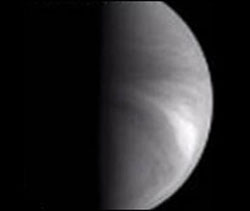Strange light area on Venus
The international astronomers were confused when they saw a huge glow in Venus's clouds.
An amateur astronomer in the city of Holtsville, New York State, USA discovered bright areas on July 19. The European Space Agency's Venus Express also confirmed this phenomenon. The data from the ship shows that the bright area appears at least 4 days before it is detected from the earth and has a minimum diameter of 10 km. Since then, the light zone has expanded continuously thanks to the winds in Venus's dense atmosphere.

The bright area on Venus (right) has a minimum diameter of 10 km. (Photo: BBC)
Scientists have not found the cause of light, but some experts believe that volcanic eruptions may be a possibility.
Volcanic lava covers 90% of Venus's surface. Although there is no solid evidence of volcanic eruption on this planet in recent decades, scientists believe that the phenomenon can still happen at all times. However, only powerful eruptions can penetrate the dense atmosphere and contain up to 96% of Venus's CO 2 .
Many people believe that the bright zone is created by the interaction between charged particles from the sun and the Venus atmosphere . Terrible turbulence on this planet (winds above Venus can reach speeds of 350 km / h) make light particles concentrated in an area in the atmosphere.
This is not the first time people have seen a huge bright area on Venus, but the latest discovery is considered unusual because only a small area emits light stronger than the rest of the planet.
Venus (also known as Morning Star, Morning Star) is the second planet from the sun in the Solar System. It has the same soil and rock as the earth. The size, mass, and gravity of Venus are close to the Earth, so these two planets are often regarded as twin planets. With the naked eye, Venus is the third brightest object in the sky, after the sun and the moon.
- Venus is easily mistaken for a UFO in the next few days
- Venus suddenly turned slower
- Overview of Venus
- 10 most interesting things about Venus
- Venus returns to the sky on the night of October 27
- Venus can stay?
- NASA wants to bring people to Venus
- Snow rain on Venus
- Venus Experss are about to plunge into the Venusian atmosphere
- Venus is about to be a
- After 8 years of Venus exploration, Venus Express has run out of fuel
- Plan to conquer human Venus
 Van Allen's belt and evidence that the Apollo 11 mission to the Moon was myth
Van Allen's belt and evidence that the Apollo 11 mission to the Moon was myth The levels of civilization in the universe (Kardashev scale)
The levels of civilization in the universe (Kardashev scale) Today Mars, the sun and the Earth are aligned
Today Mars, the sun and the Earth are aligned The Amazon owner announced a secret plan to build a space base for thousands of people
The Amazon owner announced a secret plan to build a space base for thousands of people